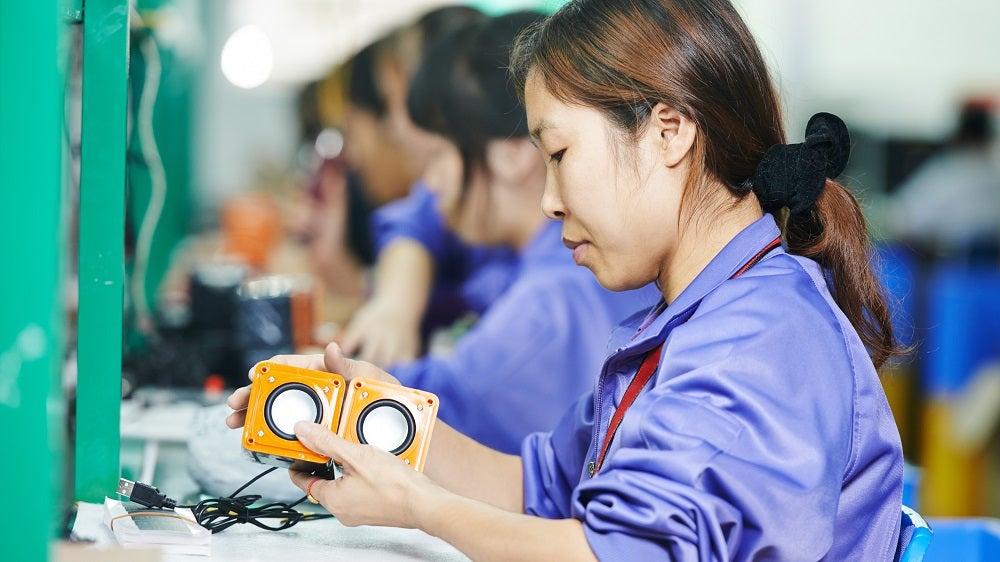 A Chinese worker assembling production at line conveyor in China factory
A Chinese worker assembling production at line conveyor in China factory
Governments should prepare for the ‘new normal’ in global value chains – here is how
This blog is part three of a 3-part series on the way in which global value chains are affected by COVID-19.
Part I. Multinational corporations and their suppliers are being hit hard
Part II. Lead firms of global value chains continue to make agile adjustments
The COVID-19 pandemic is a stress test for individuals, businesses and governments. Global value chains (GVCs) have been uniquely affected by a combination of simultaneous supply and demand shocks. Previous global crises, such as natural disasters and the 2008 global financial crisis, have also prevented firms from buying essential inputs or reduced consumer demand. However, in those cases, the disruptions were either localized or things bounced back quickly. As multinational corporations and their suppliers continually seek to enhance the resilience of their international production (blog part II), how will the pandemic affect investment policymaking, and how will it in turn affect the global value chains?
One policy shift may be that countries adopt more restrictive policies for foreign investment. This continues a trend of rising protectionism that started with withdrawals from trade agreements in recent years. In 2019, restrictions on FDI reached the highest level in 20 years. The United States and the European Union have enacted strict screenings of foreign acquisitions in response to perceived risks to national or economic security. Cases of investment withdrawals—either rejected or withdrawn investments over security concerns—tripled in 2018 alone . More recently, China and South Africa have also introduced new regulatory frameworks for FDI screening for national security concerns.
The deadly pandemic now has encouraged more nationalist policies. Several countries have tightened foreign investment screening mechanisms to protect their health sector and industries in other sectors considered as particularly important in the crisis. For example, the European Commission has called on European Union members to adopt or strenuously enforce foreign investment screening mechanisms to protect sensitive assets from foreign takeover, notably in areas such as health, medical research, biotechnology, and infrastructures. France, Germany, Italy, and Spain responded to the call. Other countries, such as Australia, are also tightening their FDI regulations. All foreign investments are now subject to further approvals by the Treasurer. Yet, screening decisions can in many cases be unclear and discourage foreign investment.
Another worrying development is that some governments are now conditioning state support on shifting production back home. Examples of this can be found in the French automotive industry and for American microchip manufacturers. Such interventions often go against economic rationale. Reshoring does not reduce supply chain risks, while the increased production costs could undermine national competitiveness and lower long-term growth across the world. These policies would also hurt low-income countries that are increasingly reliant on GVCs to stimulate economic growth.
Efforts in the current crisis should focus on assisting systematically strategic multinational corporations and their suppliers to preserve the value chains. Examples of such responses can be found in Ethiopia, Ghana, Ireland, and Saudi Arabia. They include expedition of foreign exchange approvals, and advocacy for urgent government actions to solve these companies’ grievance issues more systematically and benefit other similar investors. Some countries are also allowing companies in export-oriented industrial parks to supply locally, and facilitating multinational corporations’ expansion into new production lines as part of the country’s strategic re-orientation to in-demand products and services in light of COVID-19.
We suggest a three-part policy response.
First, get the economy ready and open for a post-crisis start. The crisis has exposed some of the structural problems faced by developing countries, such as dependence on a small number of vulnerable sectors. FDI by its nature strengthens the resilience of the economy and helps absorb future shocks through economic diversification and enhanced productivity. To attract additional investment, countries can counter the global protectionist trend by further easing entry and operational FDI restrictions as part of their structural reforms. Becoming relatively more open to foreign investors than your peers can significantly help attract investment. For example, China and India both recently announced the removal of caps on foreign equity ownership of securities and defense and allowing foreign ownership of fund management firms.
Second, seize opportunities of potentially shifting GVCs. Recent trade tension between the US and China prompted diversification of American production facilities to other East Asian countries. Now due to the COVID-19, the push to diversify supply chains may intensify, and regional supply chains may gain more momentum. Figure 1, for examples, shows the emerging competitive sectors in European and Central Asian countries, should investors are to consider diversify away from their currently China-based suppliers. Policymakers may also respond to changes in sectoral dynamics, for example the rise in e-commerce and digital health, or the decline in fossil fuels, by updating their strategic sectors. This may offer new opportunities to some developing countries, in line with their comparative advantages. Hence, while Jordan’s investment promotion agencies may choose to re-emphasize sports clothing, Eastern European countries could look for new opportunities in the production of car parts.
Figure 1: Which EBRD countries will take advantage of the diversification of global supply chains?

Should new investment opportunities emerge, these will require new priorities in investment policy and promotion reforms. Policymakers should reflect on the possible shifts and let business realities guide their policy response, building on economic fundamentals. These will entail realigning the investment incentive regimes to the new national development priorities likely to emerge post COVID-19, such as job creation. Reforms may also be needed to ensure the limitation or phasing out of crisis-related investment screening and approval mechanisms to allow for FDI entry.
Third, strengthen global collaboration and exchange. The COVID-19 pandemic has illustrated the shared public health and economic vulnerabilities faced by countries, and the importance of collaboration in resolving crisis. It has also highlighted the critical importance of exchanging data, sharing information on good practices, and strengthening collaboration. Recent history has shown that global integration through trade and investment has brought peace and prosperity to many countries. Global leaders need to work together to secure the hard-earned gains from global value chains.






Join the Conversation